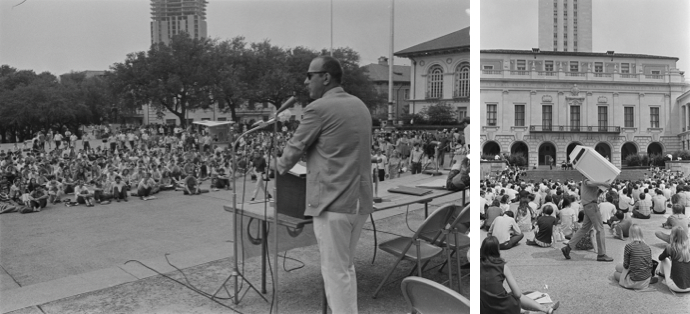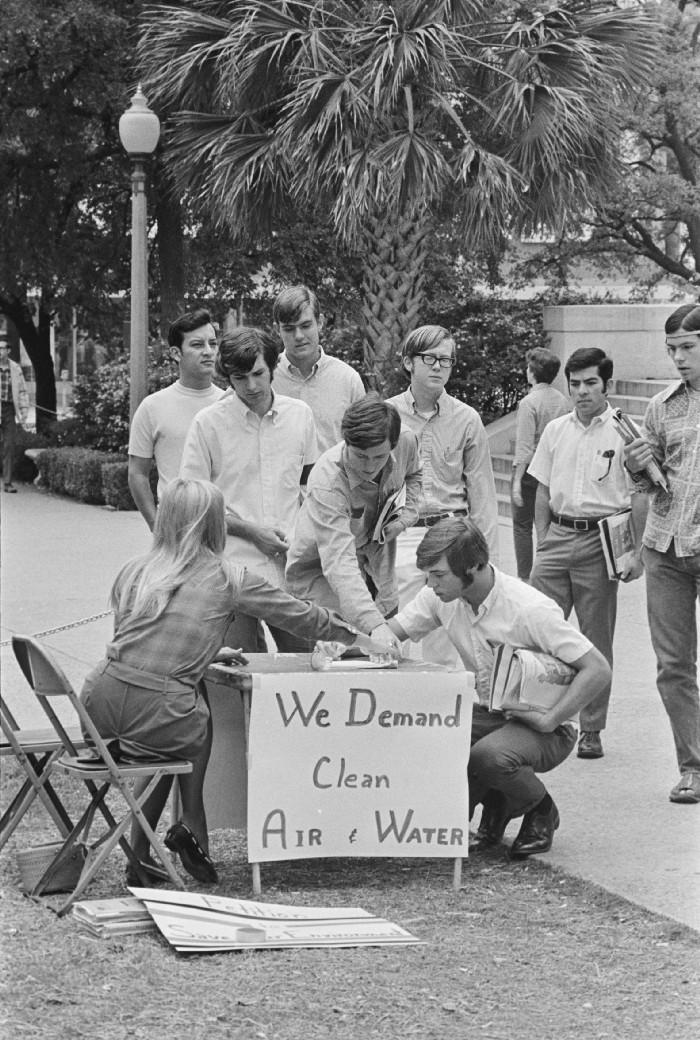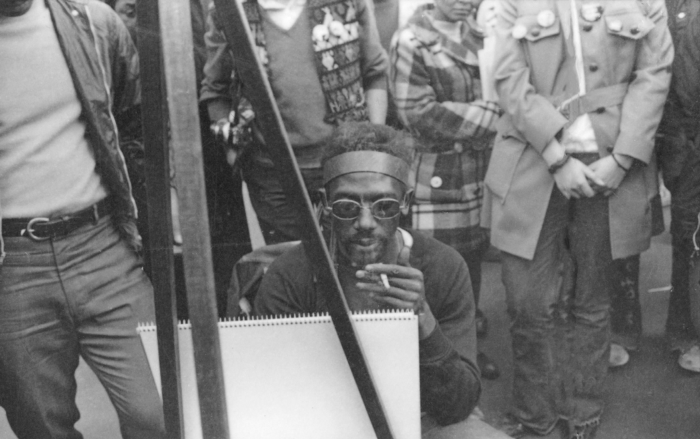
Each decade has its defining moments. The first months of 2020 have brought one of ours: the COVID-19 pandemic. We’re only beginning to fathom the physical, emotional, social, and economic pains that accompany this crisis. Such events can fracture communities, but they can also build them up. The 50th anniversary of Earth Day offers Planet Texas 2050 a chance to reflect on how defining moments can mobilize millions to envision more just and healthy futures. How crises, whether they be COVID-19 or climate change, can rouse us to redress inequities and ensure the vitality of all people and places as we plan for the days, years, and decades ahead.
Heather Houser, Associate Professor
Chair, Planet Texas 2050
April 2020
The first Earth Day 50 years ago happened at the height of spring.
In New York City, the last remnants of a winter chill hung in the air, which slowly warmed throughout the day.
University of Texas Vice President for Research Daniel Jaffe, then-16 and a high school junior, says he remembers hearing that morning about a large gathering forming in Union Square, near Lower Manhattan. A photography student, he grabbed his Pentax camera and hopped on the east side subway to get some good shots of the crowd.
When Jaffe arrived at 14th Street, throngs of people were in the road, which had been shut down to vehicle traffic. Jaffe recalls that the mix included left-wing extremists, hippies, students and police, in a festival that felt, to him, somewhere between a Vietnam War protest and Woodstock, which had taken place only a year earlier.
People danced and drank in the street. Activists waved signs for peace and to save the seals.
“It was more of a ‘happening’ than a protest,” Jaffe says, smiling as he looked at the contact sheet of pictures — saved, all these years — that he took that day in 1970. “At an anti-war protest, they would have had side streets full of cops on horseback and shields and masks, ready for anything. Here it was pretty mellow.”
However, despite the laidback atmosphere, the concerns that brought people to the streets that day were very real — air and water pollution so bad the sky often was thickened with smog and oceans and rivers clouded with chemicals discharged from factories.
“It was the end of the time when places like London and Chicago would be covered in coal smoke,” Jaffe remembers. “You basically would have died if you had fallen in the Hudson in those days. Things have changed a lot since that time in these respects.”

A Rally for the Ages
The first Earth Day, which is now celebrated annually, drew an estimated 20 million Americans to the streets and became known as the largest civic demonstration in the world’s history. Shortly after, in 1970, U.S. lawmakers passed the Clean Air Act, which put stringent vehicle and factory emissions controls in place. It also led to the creation of the Environmental Protection Agency.
Air pollution levels since that time have dropped significantly, with carbon monoxide levels down 83% since the 1980s, according to the EPA.
Jaffe, in the years that followed, mostly quit taking pictures. He went on to study astronomy, relocating to Texas for its clear skies and a perfect view of the night stars.
Today, he leads an office at UT that has organized several large, interdisciplinary research programs on campus, including the Planet Texas 2050 grand challenge. Researchers from more than a dozen disciplines are working on many of the same topics that concerned activists that very first Earth Day, like access to clean air and water, mitigating climate change and ensuring environmental justice. Their goal is to solve some of the state’s most pressing problems stemming from rapid growth and climate change.
That’s because by 2050, Texas’ population is expected to nearly double — from 28 million to 47 million — which will put a strain on its natural resources and urban infrastructure. Many of the fastest growing metropolitan areas, including those along the Interstate 35 corridor, are expected to get hotter and drier, leading to concerns about water availability. And as the Gulf of Mexico warms, more severe and dangerous storms, like Hurricane Harvey, are imminent.
Planet Texas 2050 researchers, including those from the humanities, geosciences and civil and environmental engineering, are addressing these and other environmental concerns — some of which are relatively new, while others have challenged us for generations.

Tackling Historical Challenges
Heidi Westerfield Ross, assistant director for the Transportation Network Modeling Center within UT’s Center for Transportation Research, is among several people working on a Planet Texas 2050 project to better understand transportation-related air pollution in the state.
While air pollution has improved significantly since the 1970s, including double-digit reductions in carbon monoxide, nitrogen dioxide and ozone, it is still a leading contributor to health issues, including asthma and other respiratory conditions.
Today, nearly 30% of air pollution in the United States is tied to the transportation system, the EPA has found. And low-income communities tend to be exposed at greater levels to these pollutants, often because they live along major transportation corridors, among other reasons, says Katherine Lieberknecht, Ph.D., community and regional planning assistant professor in the School of Architecture and inaugural chair for Planet Texas 2050.
Because of these inequities, the project’s researchers have set out to build a more robust picture of how air pollution effects certain communities.
Ross explains that currently available data show an incomplete picture of air quality because they focus only on the larger Central Texas region. They don’t drill down to the neighborhood level.
Researchers set out to change that by placing air quality sensors at several locations on the UT campus and in the Dove Springs neighborhood in southeast Austin, a region that happens to have disproportionate levels of childhood asthma.
With the more robust data set, researchers hope they will be able to show that measuring air pollution at the neighborhood level gives a finer-grained, and more accurate, picture of transportation-related pollution for city leaders to use in planning urban development projects.
The theme for this Earth Day is climate justice, which is another way of saying that global warming isn’t only an environmental issue but also an ethical and political one.
Because sometimes, things aren’t always what they seem, Ross says. In Austin, for instance, plans to add more density to the downtown corridor could actually increase air pollution even in places that look, on a map, to be far enough away from high-traffic areas with the most harmful emissions. The city’s hope is that by packing people into more walkable areas, they’ll be able to remove cars from the road. However, Ross and her colleagues hypothesize that the influx of people still using vehicles could lead to increased air pollution and poor health outcomes for those residents. These unintended consequences are often overlooked, she says.
“Traditionally, in our field,” Ross says, “we don’t really focus on health as a component of transportation.”
It is these kinds of complex social problems that benefit from the interdisciplinary approach employed by Planet Texas 2050. Experts from different fields often don’t see how their work overlaps, until they come together.
Taking on Climate Change
At UT’s J.J. Pickle Research Campus in north Austin, another Planet Texas 2050 team has been working to create real-time floodplain maps for the entire state using light detection and ranging data, or LiDAR. These maps are becoming critical as Texas faces worsening storms as a result of climate change.
LiDAR is a way of laser scanning the earth to reveal the vegetation, density, and other characteristics of the land by reflecting light beams off various surfaces. The state government has paid for LiDAR to be collected for the entire state, which is now being housed at UT’s Texas Advanced Computing Center for use in research.
Paola Passalacqua, Ph.D., a water resources associate professor at the Cockrell School of Engineering, has developed methods to clear “disturbances” from the LiDAR data — things like dams and culverts that interfere with getting a clear picture of the state’s stream system. This will allow researchers to create a statewide library of floodplain maps at 1-foot depth intervals, complementary to the Federal Emergency Management Agency’s flood insurance rate maps. While FEMA maps show likelihood of flooding based on historical records, they are very costly to develop and only cover about half of Texas. With the new floodplain maps, it will be possible to get a current, real-time picture of flooding based on observations anywhere in the state. This will allow city planners, first responders and emergency departments during major rain events to make the best decisions to protect people and their properties.
UT researchers are collaborating with Esri, a mapping and analytics digital platform, to use the floodplain library as part of a mobile application for first responders called Pin2Flood. During a hurricane or major flooding event, firefighters and police officers on the ground will be able to place a digital “pin” at any particular location where it’s flooding and see immediately a map of what else is at flood risk in that area — something they aren’t able to do today. David Arctur, Ph.D., a research scientist at UT’s Center for Water and the Environment, who has been mapping the entire state for the floodplain models, said this will allow emergency officials to make better, faster decisions about road closures and evacuations, which could save lives.
“Climate change is increasing the severity and the frequency of storms,” Arctur says. “These tools that we are building will help us be better prepared.”
Another team of Planet Texas 2050 researchers, led by operations research and industrial engineering associate professor Erhan Kutanoglu, Ph.D., will pick up on the evacuation side. They are working on developing a comprehensive decision making application that looks at multiple potential storm scenarios for an impending hurricane, including where a storm could hit and how much rain could fall, to make better evacuation decisions for the state’s healthcare system. These decisions include where to stage resources like ambulances and emergency personnel and how to evacuate hospitals before the hurricane strikes.
Today, those choices often are made in a silo, hospital-by-hospital and based on a single storm forecast put out by the National Hurricane Center.
“There is much more data available about the potential of a hurricane that one can take advantage of,” Kutanoglu says.
Looking at a wide array of data is important because storms are so unpredictable and only becoming more so in Texas — a reality already laid bare by Hurricane Harvey in 2017, when areas were hit by as much as 50 inches of rain as the storm sat parked over the eastern part of the state for days.
Kutanoglu’s team is about to deliver the first version of an application where a state-of-the-art hydrological model will use hurricane forecasts and area topology to predict flooding scenarios, which can then be used to optimize evacuation decisions.
“Current studies show that these kinds of events, whether they are hurricanes or just normal rainfall, will get more intense,” he says. “The old school preparedness and recovery plans, we believe, will not work. We have to do more drastic things by integrating available data, science and engineering.”

Bringing Real Change
Concerns about climate change hardly got a nod at the first Earth Day. Aside from talk about the polar ice cap melting, worries about global warming simply weren’t in the collective consciousness at the time, Jaffe recalls.
“I think the framing for Earth Day was very different at its beginning than it is now,” he acknowledges. “Part of it’s a success story, in that the Environmental Protection Agency and the Clean Water and the Clean Air Act have significantly reduced the problems that were the prominent concerns of the protesters at the time. But in the meantime, another problem, which is a more serious problem in many ways, has sprung up.”
To better address climate concerns, Planet Texas 2050 researchers have spent time building connections in the community, including working with nonprofits like Go Austin/Vamos Austin to gather the lived experience of the people most affected by things like flooding and air pollution. For instance, this could include talking to people in the Dove Springs neighborhood, an Austin community damaged significantly in recent major storms, about what areas typically back up with water between rain events and where flooding can threaten people’s lives and properties.
“The most marginalized and vulnerable populations will bear the brunt of climate change, and it is up to us to work with them to build the resilience on the ground to respond to those changes.”
GAVA Executive Director Carmen Llanes Pulido says it is this type of lived experience that is often missing from the traditional scientific data set and gives a clearer picture of inequities within the system. Climate change doesn’t affect everyone equally, she adds. Neighborhoods with poor drainage infrastructure are more adversely affected by things like flooding.
“It’s so important to have that neighborhood-level view because otherwise you don’t get the full picture,” Llanes Pulido insists. “For us, the most important piece is layering the institutional data with the lived experience.”

Lieberknecht says, with this knowledge, Planet Texas 2050 researchers hope to work with communities to better tailor solutions to fit each place so they can adapt to warmer weather and worsening storms. For instance, in some areas, elderly people might be forced to go to walk to the store in the early morning or late evening during Austin’s hot summers because their neighborhood’s main thoroughfare isn’t shaded. Could the city or nonprofits plant trees to provide some relief? And what kind of trees would most appropriately fit into the community’s culture and heritage or be most appropriate for the native ecosystem?
“There is not a one size fits all solution,” Lieberknecht adds. “Lived experience teaches us what questions to ask, and then we can figure out how to co-create strategies that are actually going to work for a place.”
The theme for this Earth Day is climate justice, which is another way of saying that global warming isn’t only an environmental issue but also an ethical and political one.
“Texas has such economic and social disparities across the state,” Lieberknecht says. “The most marginalized and vulnerable populations will bear the brunt of climate change, and it is up to us to work with them to build the resilience on the ground to respond to those changes.”
Despite living in a time of extreme political polarization, Jaffe maintains we aren’t limited in what we can accomplish. Fifty years ago, political divisions also ran deep, yet environmentalists’ efforts led to very measurable solutions we still benefit from today. Jaffe says we’re at a similarly critical juncture now.
“We have to look at this in a historical context. Our job — whatever anyone thinks about where we are as a country — is to understand what’s happening and develop possibilities for the future,” he says. “Waiting to get them started might mean we miss the moment.”
Daniel Jaffe, Ph.D., is the Jane and Roland Blumberg Centennial Professor in Astronomy and is the vice president for research at The University of Texas at Austin. In March, he was also named as UT’s interim executive vice president and provost. Dr. Jaffe’s research focuses on the formation of stars and planetary systems, which means he’s still looking through lenses— only his subjects are a bit farther away now.

